Are there rules governing the use of the national flag & emblem, singing of the national anthem? Here is a detailed explainer.
India, being home to a largely diverse demography, language & culture, is united with the national symbols which are intrinsic and unique to India. National symbols represent the country’s history, values and culture. Citizens are legally bound to show respect to such national symbols. While India is gearing up to celebrate the 71st Republic Day this year, here is a look at the key national symbols and the relevant rules about the National Flag, National Anthem and National Emblem.
The National Flag
The present National Flag of India was adopted by Constituent Assembly on 22 July 1947. Display of the flag must be in compliance with the Flag Code of India, 2002.
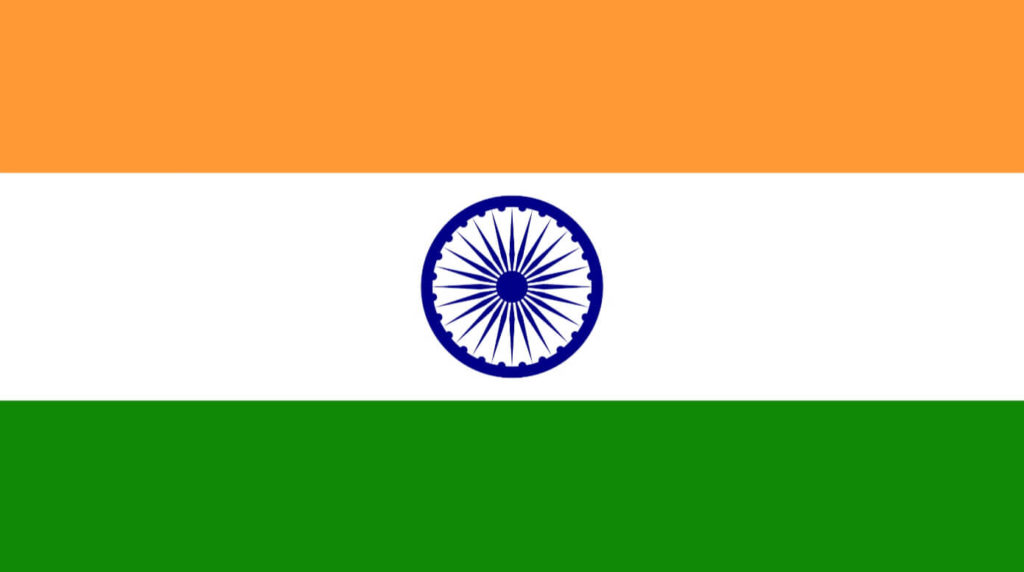
The flag should be made of hand-spun and hand-woven Wool/Cotton/Silk Khadi bunting in the prescribed dimensions.

The Ministry of Home Affairs (MHA) also directed all government offices multiple times to ensure that plastic flags are not used for any event since the disposal of the flag with dignity might not be possible.

The flag should not be used for commercial purposes and also must not be used as a portion in any kind of garment or cloth or decoration. Also, nothing is allowed to be inscribed on the flag. It should not be used to hold any item or as a cloth to wrap things except for flowers prior to unfurling. When the flag is hoisted/lowered or being carried in a parade, everyone has to stand in attention facing the flag. The flag should always be kept in the upright position with saffron at the top.
The flag should be distinctly placed and flown from sunrise to sunset. No other flag should be placed above or higher than or side by side to the National Flag. The flag will be half-masted only in the event of death of dignitaries as mentioned in the Flag Code of India.
The privilege of flying the flag on their cars is restricted to a few dignitaries who head the Executive, Legislature and Judiciary at national and state level.
Care should also be taken that a damaged flag is not displayed. It should be destroyed privately by burning or any other manner without compromising its dignity.
In some cases, permission is also granted for giant flag to be hoisted permanently. In such cases, A proposal needs to be sent to the MHA which accords permission to fly the national flag on giant flagpoles overnight. The government has stipulated the following conditions that need to be fulfilled to get a ‘No Objection’. However, these has not been added to the Flag Code of India.
- Arrangements have to be made to ensure proper illumination of the flag at night
- There should be back up in case of power failures
- If the flag gets damaged due to weather, it should be immediately replaced
The flagpole in Hyderabad’s Sanjeevaiah Park and Delhi’s Central Park in Rajeev Chowk are two examples.
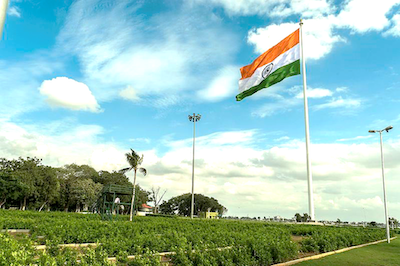
The National Anthem
Composed by Rabindranath Tagore, rendition of the full version of the National Anthem takes about 52 seconds. It is played mandatorily at certain formal events such as presentation ceremonies of Padma awards and gallantry awards, during parades and display of regimental colours. In formal State functions and other government functions involving the President/ Governor/ Lieutenant Governor, the anthem has to be played on their arrival or departure. Generally, the Anthem is not played for the Prime Minister.
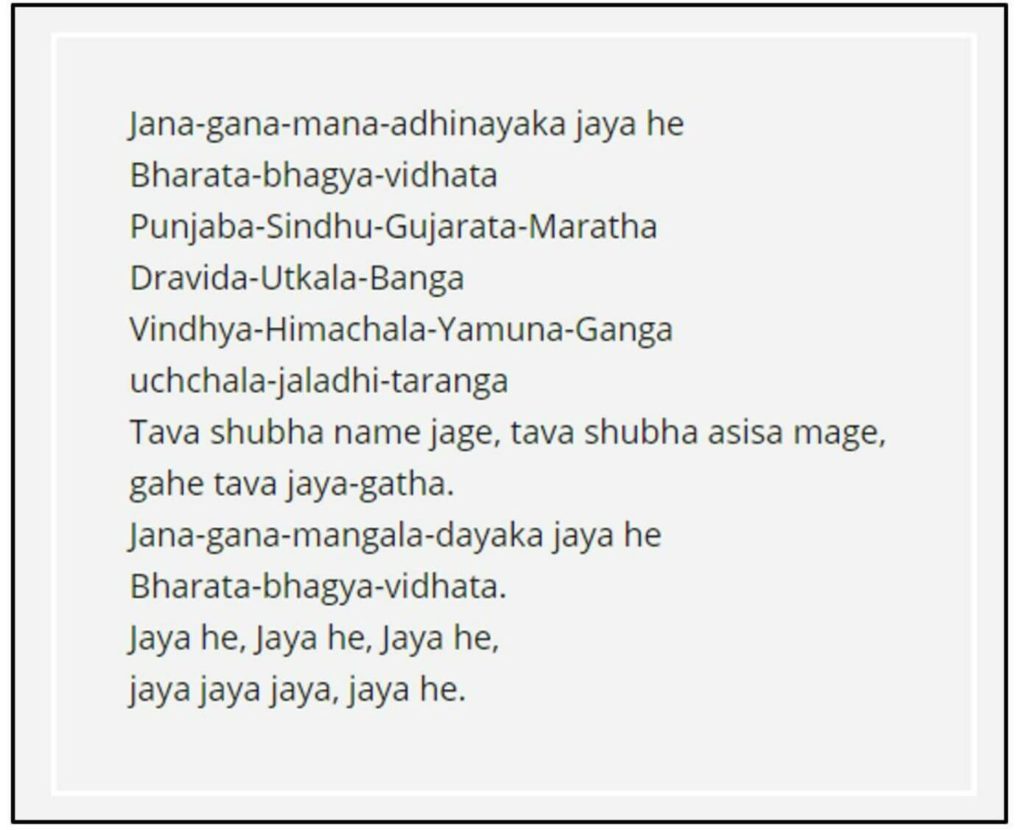
A 20-second short version of the anthem comprising the first and last two lines of the anthem is played when drinking toasts in Messes.
Playing or singing of the National Anthem is not restricted to these events. It can even be sung in events which need not be customary as long as the anthem is rendered with respect and, decorum is maintained. Schools should take necessary steps to promote the singing of National Anthem and respect for the National Flag.
The MHA in its orders mentioned that it is not possible to give an exhaustive list of occasions on which the singing of the Anthem is permitted. However, it made clear that there is no objection to the singing of the Anthem accompanied by mass singing so long as it is done with due respect as a salutation to the motherland and proper decorum is maintained.
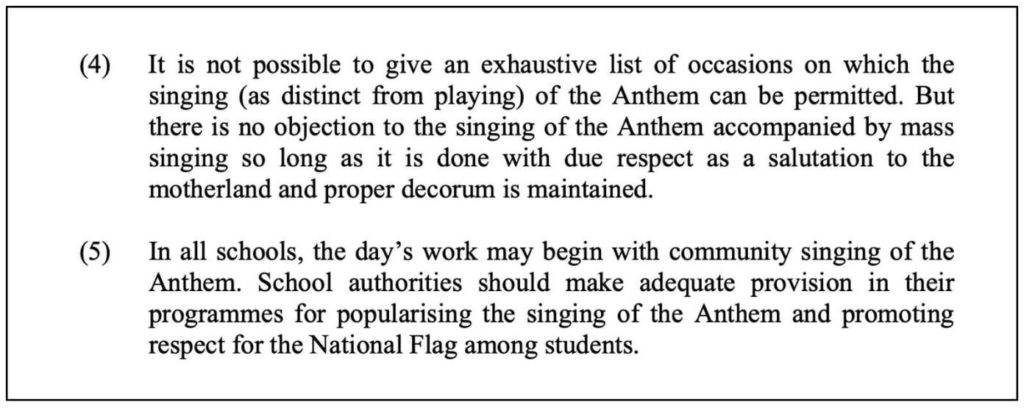
The Supreme Court in its order in 2018 stated that it is not mandatory to play the anthem prior to screening feature films in cinema halls modifying its 2016 order.
Whenever the National Anthem is rendered, the audience should stand to attention. Persons with locomotor disabilities and physically handicapped persons are exempted from standing. Also, when the rendition is in the course of a movie or newsreel, it is not necessary to stand.
The orders also go onto state the following about singing the anthem in the case of flying the national flag.

Any act of disrespect to the National Flag or Anthem is a punishable offence by law
As per the Prevention of Insults to National Honour Act, any person who intentionally prevents the singing of anthem or causes disturbance to any assembly singing the anthem is liable to be punished with imprisonment of up to three years or a penalty or both. The same punishment is applicable to those who disrespect the National Flag or Constitution of India.

The State Emblem of India
The State Emblem of India is adapted from the Sarnath Lion Capital of Amarnath. In the State Emblem, three lions on an abacus with the Dharma Chakra in the Centre, a bull on the right and a galloping horse to the left is clearly visible. The outlines of two Dharma Chakras on either end of the abacus are also seen. The motto ‘Satyameva Jayate’ in Devanagiri script at the bottom is also a part of the emblem and translates to ‘Truth alone Triumphs’.
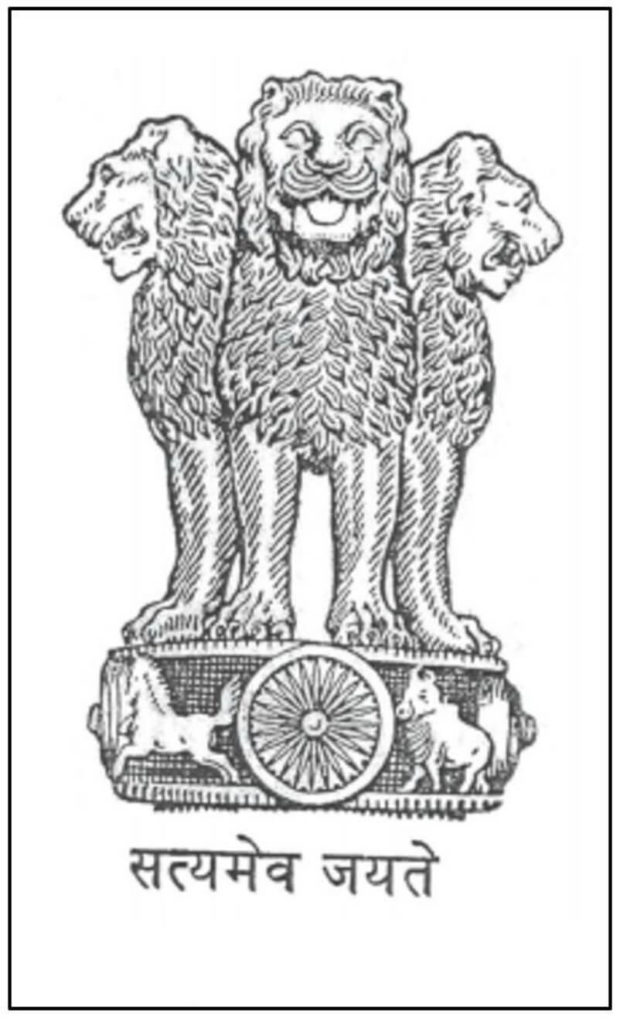
Only specified authorities and officials are allowed to use the seal for official purposes and on stationery. This includes President, Vice President, Prime Minister, Ministers, MPs, MLAs, and their offices, Departments, Commissions, officers and offices at both state and national level set up by an Act in the parliament. Similarly, the symbol can be displayed on cars by a few higher officials only. The emblem can be displayed in cards, stamps, advertisements, cutlery, websites, medals, currency, badges and stationery by the government only.
Time and again, the MHA issues circulars to offices urging them to use the symbol in stamps and stationery prominently and clearly along with the motto at the bottom.
The State Emblem of India (Prohibition of Improper Use) Act, 2005 regulates the usage of the National Symbol. According to the Act, no one is allowed to use the symbol to mislead people into thinking that it relates to the government. Apart from not permitting the usage of the emblem for commercial purposes, the act also prohibits the usage of the symbol by people for trademark or patent. Violating this law would result in imprisonment up to two years or fine up to Rs. 5000 or both.
Featured Image: National Symbols of India



2 Comments
Is this correct?: As per an amendment, the National Flag need not be lowered at dusk. It can be flown through the night, Only condition is the flag must be well-lit..:
In some cases, permission is also granted for giant flag to be hoisted permanently. In such cases, A proposal needs to be sent to the MHA which accords permission to fly the national flag on giant flagpoles overnight. The government has stipulated the few conditions that need to be fulfilled to get a ‘No Objection’. The article is updated with relevant links. However, these has not been added to the Flag Code of India.
The flagpole in Hyderabad’s Sanjeevaiah Park and Delhi’s Central Park in Rajeev Chowk are two such examples.